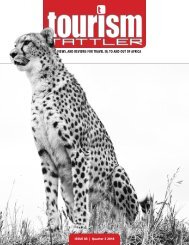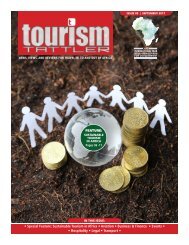Tourism Tattler Issue 1 of 2018
The first issue of TourismTattler’s quarterly magazine features the Magic of Kenya, the Secret Season of South Africa’s Whale Coast, the rehabilitation of Pendjari National Park in Benin, and a whole lot more about travel and business tourism in Africa.
The first issue of TourismTattler’s quarterly magazine features the Magic of Kenya, the Secret Season of South Africa’s Whale Coast, the rehabilitation of Pendjari National Park in Benin, and a whole lot more about travel and business tourism in Africa.
You also want an ePaper? Increase the reach of your titles
YUMPU automatically turns print PDFs into web optimized ePapers that Google loves.
BUSINESS & FINANCE<br />
Africa’s Hotel Market:<br />
The 2017 Year in Review<br />
The African hotel market experienced another eventful and evolutionary year in 2017.<br />
The continent continued to attract new regional and global investment, whilst economic<br />
and political events, currency shifts and fluctuating tourism demand brought both risks<br />
and rewards to hotel markets across the region.<br />
By Wayne Troughton.<br />
Both upward and downward trends were noticeable across the<br />
continent in 2017, with more positive conditions in West Africa<br />
as oil economies geared up in response to a recovering oil price.<br />
Political instability in several East African countries served to<br />
dampen those markets in the area, albeit on a temporary basis.<br />
Here, then, is a brief summary <strong>of</strong> the top and bottom five<br />
performers across 14 African cities for 2017, as indicated by STR<br />
Global. Occupancy rates, Average Daily Rates, rooms sold and<br />
future supply have all been taken into account.<br />
Occupancy Rates<br />
In terms <strong>of</strong> occupancy growth, Lagos and Accra led the 14<br />
African cities assessed (vs. Cape Town and Lusaka in 2016)<br />
as gradual economic recovery in the countries <strong>of</strong> Nigeria and<br />
Ghana saw both these cities benefit from increased business<br />
demand. Growth in Lagos came <strong>of</strong>f a low base, however, and,<br />
in light <strong>of</strong> more positive economic projections, should see future<br />
occupancy rates boosted to former highs.<br />
Strong growth in Accra (Ghana) propelled occupancy rates to a<br />
healthy level just above 60%. Other markets showing moderate<br />
growth included the South African cities <strong>of</strong> Pretoria, Windhoek<br />
and Durban, whilst Namibia’s economy revealed signs <strong>of</strong><br />
recovery after poor economic growth in 2016.<br />
Nairobi’s (Kenya) occupancy performance was the weakest<br />
<strong>of</strong> the cities assessed, with a decline in occupancy <strong>of</strong> 11.1%.<br />
Here, new supply (an additional 478 rooms, <strong>of</strong> which 334<br />
were internationally branded - Four Points by Sheraton, Park<br />
12 <strong>Tourism</strong> <strong>Tattler</strong> Trade Journal Quarter 1 <strong>2018</strong> Jan/Feb/Mar<br />
Inn) coupled with a decline in demand due to the violence<br />
surrounding the August 2017 elections substantially reduced<br />
accommodation demand. Dar es Salaam (Tanzania) followed<br />
Nairobi with a decline in occupancy <strong>of</strong> 9%. This was driven<br />
largely by investor uncertainty in new government policy,<br />
limiting business travel to the city. Additionally, direct flights<br />
to key tourism destinations reduced leisure demand in Dar es<br />
Salaam.<br />
Lower occupancies in Addis Ababa (Ethiopia) and Gaborone<br />
(Botswana) continued into 2017, following an occupancy<br />
decline <strong>of</strong> 10.% and 7.1% respectively in 2016. Although<br />
supply increased in these cities, demand declined due to political<br />
unrest (Addis Ababa) and economic challenges driven by mining<br />
(Botswana).<br />
Average Daily Rates<br />
Nine <strong>of</strong> the cities assessed achieved ADR growth in US Dollar<br />
terms in 2017, as opposed to only two <strong>of</strong> the 13 cities reviewed<br />
in 2016. Windhoek (Namibia) was the market leader followed by<br />
South Africa’s Cape Town, Pretoria, Sandton and Umhlanga.<br />
Strong growth in these cities was driven largely by the<br />
strengthening <strong>of</strong> the SA Rand against the US dollar (the<br />
Namibian dollar is pegged against the SA Rand). However, in<br />
local currency terms, only Windhoek (9.9% growth) and Cape<br />
Town (7.2% growth) were positioned in the top five growth<br />
markets. Local currency growth in the Pretoria, Sandton and<br />
Umhlanga markets was well below inflation (5.4% in 2017).

















